中华人民共和国知识产权海关保护条例.doc
知识产权监管相关法律法规
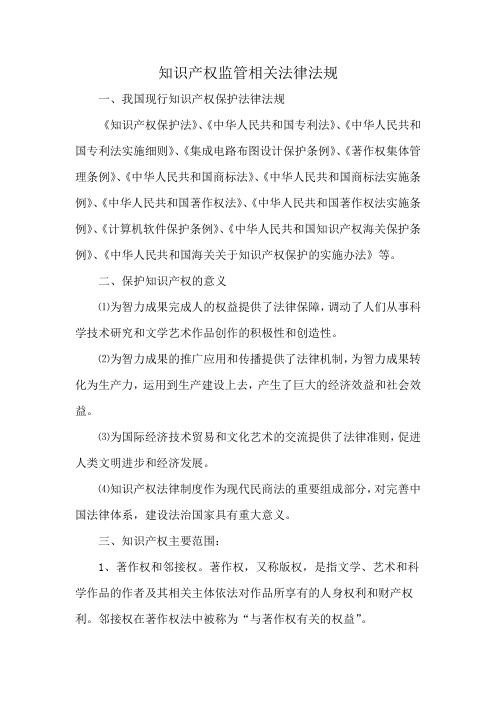
知识产权监管相关法律法规
一、我国现行知识产权保护法律法规
《知识产权保护法》、《中华人民共和国专利法》、《中华人民共和国专利法实施细则》、《集成电路布图设计保护条例》、《著作权集体管理条例》、《中华人民共和国商标法》、《中华人民共和国商标法实施条例》、《中华人民共和国著作权法》、《中华人民共和国著作权法实施条例》、《计算机软件保护条例》、《中华人民共和国知识产权海关保护条例》、《中华人民共和国海关关于知识产权保护的实施办法》等。
二、保护知识产权的意义
⑴为智力成果完成人的权益提供了法律保障,调动了人们从事科学技术研究和文学艺术作品创作的积极性和创造性。
⑵为智力成果的推广应用和传播提供了法律机制,为智力成果转化为生产力,运用到生产建设上去,产生了巨大的经济效益和社会效益。
⑶为国际经济技术贸易和文化艺术的交流提供了法律准则,促进人类文明进步和经济发展。
⑷知识产权法律制度作为现代民商法的重要组成部分,对完善中国法律体系,建设法治国家具有重大意义。
三、知识产权主要范围:
1、著作权和邻接权。
著作权,又称版权,是指文学、艺术和科学作品的作者及其相关主体依法对作品所享有的人身权利和财产权利。
邻接权在著作权法中被称为“与著作权有关的权益”。
2、专利权,即自然人、法人或其他组织依法对发明、实用新型和外观设计在一定期限内享有的独占实施权。
3、商标权,即商标注册人或权利继受人在法定期限内对注册商标依法享有的各种权利。
4、商业秘密权,即民事主体对属于商业秘密的技术信息或经营信息依法享有的专有权利。
5、植物新品种权,即完成育种的单位或个人对其授权的品种依法享有的排他使用权。
《海关监管条件》海关监管的依据

遇到国际法问题?赢了网律师为你免费解惑!访问>>《海关监管条件》海关监管的依据【海关监管条件】海关监管的依据进出口许可管理制度进出口许可管理制度是根据国家对外贸易方针政策,对进出口货物由经贸主管部门签发许可证等方式来实施管理的一项制度。
它是海关监管和验放进出口货物的重要依据之一,这在《海关法》里有明文规定。
进出口许可证是保护和稳定国内经济免受国际市场冲击的一项有效措施。
但随着我国申请加入世界贸易组织,进出口许可证作为一项非关税措施,如何控制并减少其管理范围,已成为我国外贸制度与国际惯例接轨和顺利进入世界贸易组织的敏感问题。
商检制度商品检验制度是指商品检验机构对进出口商品的质量、规格、重量、数量、包装、残损等依法进行检验,出具检验证书。
此外,商检机构还负责对出口食品的卫生检疫和向非协议国家出口动物产品的病虫害检疫,对进口货物的环保状况进行鉴定。
国家出入境检验疫局是我国负责检验进出口商品的主管机构,由该机构制定、调整并发布的《出入境检验检疫机构实施检验检疫的进出境商品目录》,调整后的《检验检疫商品目录》涉及编码商品4113个。
我国商品检验的种类分为4种,即法定检验、合同检验、公证鉴定和委托检验。
法定检验是指根据国家规定,对进出口商品实施强制性的检验,凡列入《出入境检验检疫机构实施检验检疫的进出境商品目录》的进出口商品均属法定检验商品;进口时,海关凭商检机关拓报关单上加盖的印章放行。
出口时,报验手续在向海关申报之前进行。
海关凭商检机构的检验证书、放行单,或凭其在报关单上加盖的印章验放。
动植物检疫制度为了防止动物传染病、寄生虫病和植物危险性病、虫、杂草及其他有害生物的传播和蔓延,保障我国农、林、牧、渔业生产和人体健康,维护我国的对外信誉,国家规定对进出境的动植物及其产品实施检疫。
凡属应当施行动植物检疫的进出境货物,无论以何种贸易方式进出境,都应当在报关前报请入境或出境口岸的动植物检疫机构实施检疫,由动、植物检疫机构发给《检疫放行通知单》或在货运单据上加盖检疫放行章后,再向海关申报。
我国现行知识产权保护法律法规有哪些

You have to make friends with people who dare to accuse you of your shortcomings, criticize you face to face, and stay away from people who flatter your shortcomings and who have been joking about you!通用参考模板(页眉可删)我国现行知识产权保护法律法规有哪些我国现行知识产权保护法主要有知识产权保护法,专利法实施细则,著作权管理条例商标法,计算机软件保护条例,中华人民共和国知识产权海关保护条例等相关法律制度。
因为知识产权本身包含的范围也比较多,所以不同的知识产权对应的法律制度也不一样。
一、我国现行知识产权保护法律法规有哪些?《知识产权保护法》《中华人民共和国专利法》《中华人民共和国专利法实施细则》《集成电路布图设计保护条例》《著作权集体管理条例》《中华人民共和国商标法》《中华人民共和国商标法实施条例》《中华人民共和国著作权法》《中华人民共和国著作权法实施条例》《计算机软件保护条例》《中华人民共和国知识产权海关保护条例》《中华人民共和国海关关于知识产权保护的实施办法》等。
二、保护知识产权的意义⑴为智力成果完成人的权益提供了法律保障,调动了人们从事科学技术研究和文学艺术作品创作的积极性和创造性。
⑵为智力成果的推广应用和传播提供了法律机制,为智力成果转化为生产力,运用到生产建设上去,产生了巨大的经济效益和社会效益。
⑶为国际经济技术贸易和文化艺术的交流提供了法律准则,促进人类文明进步和经济发展。
⑷知识产权法律制度作为现代民商法的重要组成部分,对完善中国法律体系,建设法治国家具有重大意义。
三、知识产权主要范围:1、著作权和邻接权。
著作权,又称版权,是指文学、艺术和科学作品的作者及其相关主体依法对作品所享有的人身权利和财产权利。
报关员考试海关主要法律法规考试真题与答案

报关员考试海关主要法律法规真题及答案、单选1. 根据《中华人民共和国海关法稽查条例》的规定,与进出口活动直接有关的企业、单位应当自进出口货物放行之日起多少年内保管好报关单证、进出口单证、合同以及与进出口业务直接有关的其他资料。
A. 1年B.2年C.3年D.永久2. 下列陈述中,其中一项是错误的,请予以指出。
A .《中华人民共和国海关法》由全国人民代表大会常务委员会通过并发布实施。
B .《中华人民共和国海关法行政处罚实施细则》由海关总属发布实施。
C •《中华人民共和国进出口关税条例》由国务院关税税则委员会发布实施。
D .《中华人民共和国知识产权海关保护条列》由国务院发布实施。
3. 根据《中华人民共和国海关法》,下列行为中,不属走私罪的行为是:A •未经海关许可,擅自开拆、提取、交付、发运、调换、改装、抵押或者转让海关监管货物的B. 以暴力抗拒检查走私物品的,数额不大的C .以牟利、传播为目的,邮寄国家禁止出口的文物出境的D •携带国家禁止进出口的毒品进出境的4. 根据《中华人民共和国海关法》的规定,进出口货物的纳税义务人,应当何时缴纳税款。
A. 填发税款缴纳证之日起7 日内B .填发税款缴纳证次日起7 日内C .填发税款缴纳证之日起10 日内D.填发税款缴纳证次日起10日内5. 某进出口公司经海关实施稽查后,于1 998年1 0月8日收到海关的稽查报告,该公司向海关送交其对稽查报告的书面意见的最后有效期限是:A. 1998 年10 月14 日B. 1998 年10 月23 日C. 1998 年10 月15 日D. 1998 年11 月9 日6. 根据《中华人民共和国海关法行政处罚实施细则》的规定,经营保税货物下列哪组业务,有关记录不真实或者数量短少不能提供正当理由的,海关处货物、物品等值以下或者应缴税款两倍以下的罚款。
A. 收存、交付、加工、装配、核销B. 运输、交付、加工、抵押、转让C .储存、交付、加工、装配、寄售D. 储存、运输、加工、装配、寄售7. 海关在应知识产权权利人的申请扣留侵权嫌疑货物后,收货人或者发货人认为其进出口货物未侵犯申请人知识产权的,应当自海关扣留凭单送达之日起多长时间内向海关提出书面说明。
中华人民共和国海关关于《中华人民共和国知识产权海关保护条例》的实施办法(2018修改)

中华人民共和国海关关于《中华人民共和国知识产权海关保护条例》的实施办法(2018修改)文章属性•【制定机关】中华人民共和国海关总署•【公布日期】2018.05.29•【文号】海关总署令第240号•【施行日期】2018.07.01•【效力等级】部门规章•【时效性】现行有效•【主题分类】海关综合规定正文中华人民共和国海关关于《中华人民共和国知识产权海关保护条例》的实施办法(2009年3月3日海关总署令第183号发布根据2018年5月29日海关总署令第240号《海关总署关于修改部分规章的决定》修改)第一章总则第一条为了有效实施《中华人民共和国知识产权海关保护条例》(以下简称《条例》),根据《中华人民共和国海关法》以及其他法律、行政法规,制定本办法。
第二条知识产权权利人请求海关采取知识产权保护措施或者向海关总署办理知识产权海关保护备案的,境内知识产权权利人可以直接或者委托境内代理人提出申请,境外知识产权权利人应当由其在境内设立的办事机构或者委托境内代理人提出申请。
知识产权权利人按照前款规定委托境内代理人提出申请的,应当出具规定格式的授权委托书。
第三条知识产权权利人及其代理人(以下统称知识产权权利人)请求海关扣留即将进出口的侵权嫌疑货物的,应当根据本办法的有关规定向海关提出扣留侵权嫌疑货物的申请。
第四条进出口货物的收发货人或者其代理人(以下统称收发货人)应当在合理的范围内了解其进出口货物的知识产权状况。
海关要求申报进出口货物知识产权状况的,收发货人应当在海关规定的期限内向海关如实申报并提交有关证明文件。
第五条知识产权权利人或者收发货人向海关提交的有关文件或者证据涉及商业秘密的,知识产权权利人或者收发货人应当向海关书面说明。
海关实施知识产权保护,应当保守有关当事人的商业秘密,但海关应当依法公开的信息除外。
第二章知识产权备案第六条知识产权权利人向海关总署申请知识产权海关保护备案的,应当向海关总署提交申请书。
申请书应当包括以下内容:(一)知识产权权利人的名称或者姓名、注册地或者国籍、通信地址、联系人姓名、电话和传真号码、电子邮箱地址等。
海关总署公告2011年第1号--总担保保函(格式)
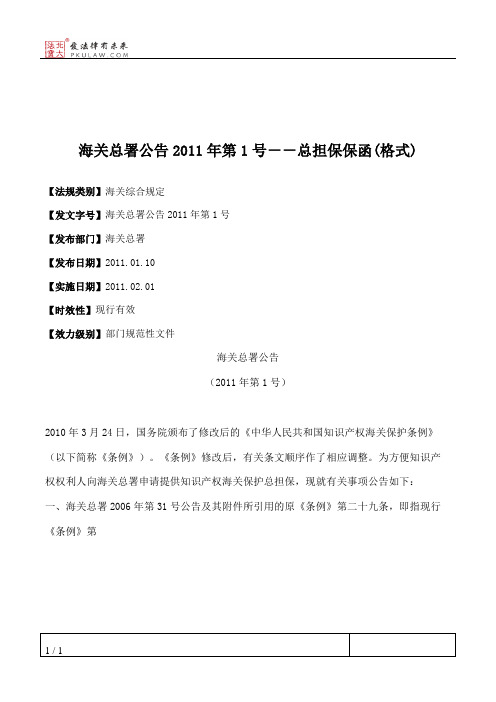
1 / 1 海关总署公告2011年第1号--总担保保函(格式)
【法规类别】海关综合规定
【发文字号】海关总署公告2011年第1号
【发布部门】海关总署
【发布日期】2011.01.10
【实施日期】2011.02.01
【时效性】现行有效
【效力级别】部门规范性文件
海关总署公告
(2011年第1号)
2010年3月24日,国务院颁布了修改后的《中华人民共和国知识产权海关保护条例》(以下简称《条例》)。
《条例》修改后,有关条文顺序作了相应调整。
为方便知识产权权利人向海关总署申请提供知识产权海关保护总担保,现就有关事项公告如下:一、海关总署2006年第31号公告及其附件所引用的原《条例》第二十九条,即指现行《条例》第。
中华人民共和国知识产权海关保护条例
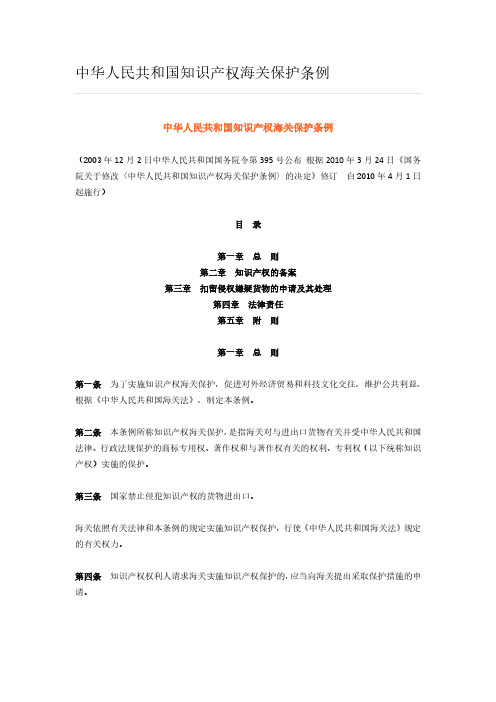
中华人民共和国知识产权海关保护条例(2003年12月2日中华人民共和国国务院令第395号公布根据2010年3月24日《国务院关于修改〈中华人民共和国知识产权海关保护条例〉的决定》修订自2010年4月1日起施行)目录第一章总则第二章知识产权的备案第三章扣留侵权嫌疑货物的申请及其处理第四章法律责任第五章附则第一章总则第一条为了实施知识产权海关保护,促进对外经济贸易和科技文化交往,维护公共利益,根据《中华人民共和国海关法》,制定本条例。
第二条本条例所称知识产权海关保护,是指海关对与进出口货物有关并受中华人民共和国法律、行政法规保护的商标专用权、著作权和与著作权有关的权利、专利权(以下统称知识产权)实施的保护。
第三条国家禁止侵犯知识产权的货物进出口。
海关依照有关法律和本条例的规定实施知识产权保护,行使《中华人民共和国海关法》规定的有关权力。
第四条知识产权权利人请求海关实施知识产权保护的,应当向海关提出采取保护措施的申请。
第五条进口货物的收货人或者其代理人、出口货物的发货人或者其代理人应当按照国家规定,向海关如实申报与进出口货物有关的知识产权状况,并提交有关证明文件。
第六条海关实施知识产权保护时,应当保守有关当事人的商业秘密。
第二章知识产权的备案第七条知识产权权利人可以依照本条例的规定,将其知识产权向海关总署申请备案;申请备案的,应当提交申请书。
申请书应当包括下列内容:(一)知识产权权利人的名称或者姓名、注册地或者国籍等;(二)知识产权的名称、内容及其相关信息;(三)知识产权许可行使状况;(四)知识产权权利人合法行使知识产权的货物的名称、产地、进出境地海关、进出口商、主要特征、价格等;(五)已知的侵犯知识产权货物的制造商、进出口商、进出境地海关、主要特征、价格等。
前款规定的申请书内容有证明文件的,知识产权权利人应当附送证明文件。
第八条海关总署应当自收到全部申请文件之日起30个工作日内作出是否准予备案的决定,并书面通知申请人;不予备案的,应当说明理由。
知识产权的海关保护法律制度及完善

知识产权的海关保护法律制度及完善□张永亮,徐金锋(浙江林学院,浙江临安311300)摘要:知识产权海关保护是用行政手段对知识产权侵权产品的跨国交易进行规制,目的在于将侵权货物阻止在海关边境外,不让其进入一国或一单独关税区的商业流通,以免破坏正常的经济贸易秩序。
我国已建立起相对完备的知识产权海关保护法律制度,但在具体制度方面存在不合理的方面,不利于保护相关权利人的利益。
本文分析了我国知识产权海关保护法律制度的现状,对其不足进行探析,并提出了相应的法律完善措施。
关键词:知识产权;知识产权海关保护;保护模式;完善中图分类号:D923.4文献标识码:A文章编号:1007-8207(2008)07-0119-03收稿日期:2008-05-05作者简介:张永亮(1975—),男,河南方城人,浙江林学院人文学院法律系讲师;徐金锋(1979—),男,浙江诸暨人,浙江林学院人文学院法律系讲师。
实施知识产权海关保护是我国参加世界贸易组织的承诺,也是《TRIPS协议》对成员国的要求。
随着全球经济一体化进程的加快,国际经贸对于一个国家越来越重要,而货物进出境也越来越成为国际商贸中十分重要的一环,在这一环节上实施知识产权保护措施,可起到事半功倍的作用。
一、我国知识产权海关保护制度的法律体系新中国成立后,自1994年起海关开始承担知识产权保护工作以后,经过10多年的探索和努力,知识产权海关保护成为我国海关的一项重要职责。
在这10多年里,海关的知识产权保护工作经历了从无到有、从小到大和从弱到强的发展历程,从执法实践到理论研究,都日渐丰富。
1992年1月17日,知识产权海关保护的概念在我国开始使用,中美在华盛顿签署《关于保护知识产权的谅解备忘录》。
这是在有关双边协定中,中国政府首次承诺在进口环节实施知识产权保护措施。
1994年7月5日,国务院发布《关于进一步加强海关知识产权保护工作的决定》,宣布侵犯受中华人民共和国知识产权法律和行政法规保护的货物禁止进出境。
知识产权海关保护考核试卷

D.《中华人民共和国专利法》
( )
15.海关在处理侵权案件时,以下哪些做法是合理的?
A.及时通知权利人
B.听取权利人和涉嫌侵权人的陈述
C.保护涉嫌侵权人的合法权益
D.公开处理结果
( )
16.以下哪些情况下,涉嫌侵权的企业或个人可能会被追究刑事责任?
A.侵权行为涉及较大金额
B. 5个工作日
C. 10个工作日
D. 15个工作日
( )
11.以下哪种情况下,海关可以对涉嫌侵权的货物进行强制扣留?
A.有权机关的扣留通知书
B.权利人的申请
C.海关现场查验发现侵权嫌疑
D.以上都正确
( )
12.关于知识产权海关保护,以下哪种说法错误?
A.海关对侵权货物有权进行扣押、没收
B.权利人可以向海关申请保护
( )
4.海关在知识产权保护中,对侵权货物的处理措施是?
A.扣押、没收
B.罚款、拘留
C.责令停止侵权行为
D.以上都正确
( )
5.在我国,以下哪个单位有权向海关申请知识产权保护?
A.权利人或者其代理人
B.任何单位和个人
C.仅权利人
D.仅权利人的代理人
( )
6.海关在查处侵权货物时,下列哪种情况下可以不通知权利人?
B.未经许可使用与他人注册商标相似的标识
C.使用自己合法注册的商标
D.以上都正确
( )
9.申请海关知识产权保护的权利人需要向海关提供以下哪些材料?
A.权利人的身份证明和知识产权证明
B.侵权证据
C.申请书
D.以上都正确
( )
10.海关对涉嫌侵权的货物进行查扣后,应在多少个工作日内作出是否侵权的决定?
我国知识产权法律、法规文件
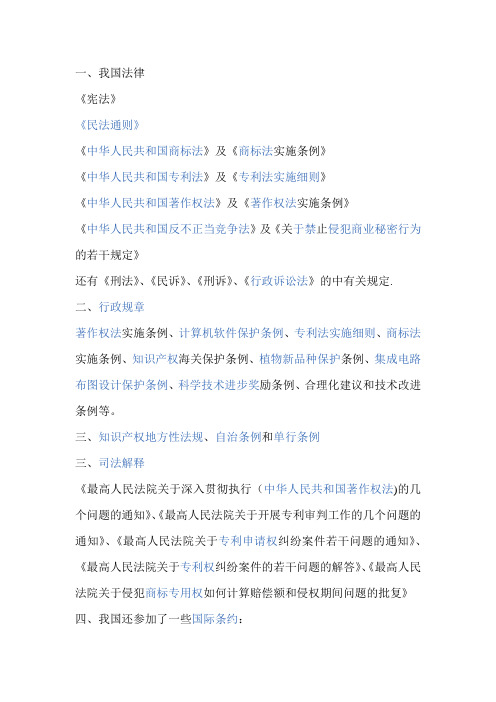
一、我国法律
《宪法》
《民法通则》
《中华人民共和国商标法》及《商标法实施条例》
《中华人民共和国专利法》及《专利法实施细则》
《中华人民共和国著作权法》及《著作权法实施条例》
《中华人民共和国反不正当竞争法》及《关于禁止侵犯商业秘密行为的若干规定》
还有《刑法》、《民诉》、《刑诉》、《行政诉讼法》的中有关规定.
二、行政规章
著作权法实施条例、计算机软件保护条例、专利法实施细则、商标法实施条例、知识产权海关保护条例、植物新品种保护条例、集成电路布图设计保护条例、科学技术进步奖励条例、合理化建议和技术改进条例等。
三、知识产权地方性法规、自治条例和单行条例
三、司法解释
《最高人民法院关于深入贯彻执行(中华人民共和国著作权法)的几个问题的通知》、《最高人民法院关于开展专利审判工作的几个问题的通知》、《最高人民法院关于专利申请权纠纷案件若干问题的通知》、《最高人民法院关于专利权纠纷案件的若干问题的解答》、《最高人民法院关于侵犯商标专用权如何计算赔偿额和侵权期间问题的批复》四、我国还参加了一些国际条约:
《知识产权协定(TRIPs协定)》、《巴黎公约》、《伯乐尼公约》、《世界版权公约》、《马德里协定》、《专利合作条约》。
海关知识产权保护介绍
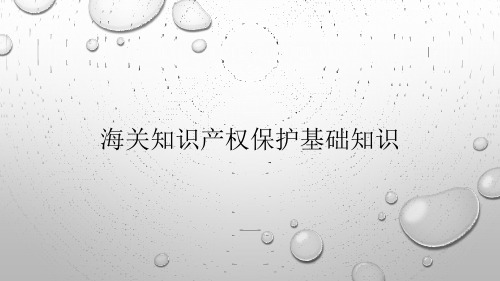
2.依职权保护流程
依职权保护,也称主动保护,是指海关发现进出口货物涉嫌侵犯已在海关总署备案的知识产权的,应当立即书 面通知权利人,权利人自通知送达之日起3个工作日内提交采取知识产权海关保护措施的书面申请及相关担保的 ,海关依法扣留侵权嫌疑货物,并自扣留之日起30个工作日内对被扣留的侵权嫌疑货物是否侵犯知识产权进行 调查、认定、作出有关行政裁决。
3. 海关执法过程中发现:
2022年3月,南通某公司以一般贸易方式向N海关申报出口被套、床盖三件套。经 查验,发现该批货物中有286条被套使用了“MICKEY MOUSE”“DISNEY”“Mickey Mouse device” “MANCHESTER UNITED及图形”标识和“MY LITTLE PONY(“小马宝 莉”)”“Supreme标识”,涉嫌侵犯迪士尼企业公司、曼彻斯特联合有限公司在 海关总署备案的商标权和孩之宝有限公司、章节四公司在海关总署备案的著作权, 涉案货值7078.66元。该批被套包装简陋、质量粗糙,且当事人无法提供相应的授 权文书,存在较大的侵权嫌疑。经联系权利人确权,4家权利人均依照《保护条例》 第十六条和《实施办法》第二十二条、第二十三条之规定,在法定期限内提交采取 知识产权海关保护措施的书面申请及相关担保,N海关依法对该批侵权嫌疑被套予 以扣留。经调查,N海关对该批侵权被套作出认定侵权的结论,并依法作出没收并 处罚款人民币355元的行政处罚决定。
(备案是海关采取依职权保护措施的前提条件。如果不备案,海关就无法对涉嫌侵权的货物进行调
查处理。目前备案不收费。)
四、知识产权海关备案方法
企业如何进行知识产权海关保护备案?
企业可以自行办理备案申请,也 可以委托代理人办理。境外的法人、 自然人和其他组织必须委托境内的企 业办理。
海关总署关于知识产权海关保护备案的收费规定-
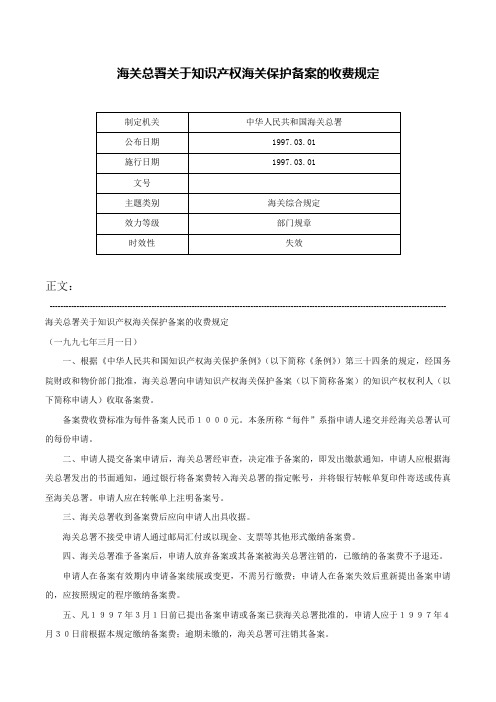
海关总署关于知识产权海关保护备案的收费规定正文:---------------------------------------------------------------------------------------------------------------------------------------------------- 海关总署关于知识产权海关保护备案的收费规定(一九九七年三月一日)一、根据《中华人民共和国知识产权海关保护条例》(以下简称《条例》)第三十四条的规定,经国务院财政和物价部门批准,海关总署向申请知识产权海关保护备案(以下简称备案)的知识产权权利人(以下简称申请人)收取备案费。
备案费收费标准为每件备案人民币1000元。
本条所称“每件”系指申请人递交并经海关总署认可的每份申请。
二、申请人提交备案申请后,海关总署经审查,决定准予备案的,即发出缴款通知,申请人应根据海关总署发出的书面通知,通过银行将备案费转入海关总署的指定帐号,并将银行转帐单复印件寄送或传真至海关总署。
申请人应在转帐单上注明备案号。
三、海关总署收到备案费后应向申请人出具收据。
海关总署不接受申请人通过邮局汇付或以现金、支票等其他形式缴纳备案费。
四、海关总署准予备案后,申请人放弃备案或其备案被海关总署注销的,已缴纳的备案费不予退还。
申请人在备案有效期内申请备案续展或变更,不需另行缴费;申请人在备案失效后重新提出备案申请的,应按照规定的程序缴纳备案费。
五、凡1997年3月1日前已提出备案申请或备案已获海关总署批准的,申请人应于1997年4月30日前根据本规定缴纳备案费;逾期未缴的,海关总署可注销其备案。
六、本规定自1997年3月1日起实施。
——结束——。
中华人民共和国知识产权海关保护条例
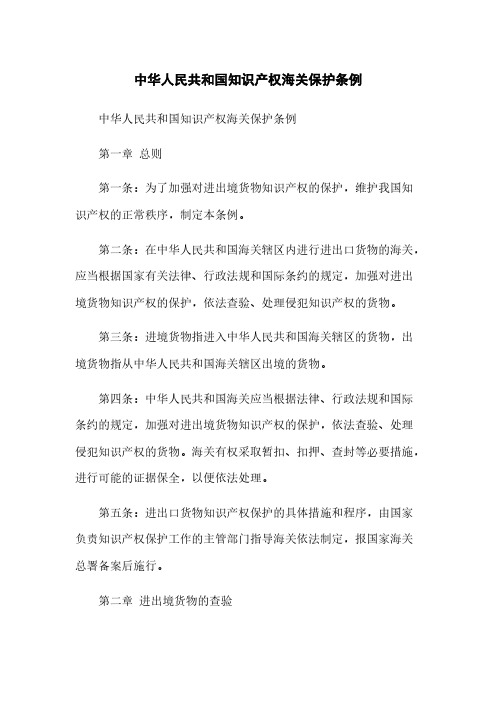
中华人民共和国知识产权海关保护条例中华人民共和国知识产权海关保护条例第一章总则第一条:为了加强对进出境货物知识产权的保护,维护我国知识产权的正常秩序,制定本条例。
第二条:在中华人民共和国海关辖区内进行进出口货物的海关,应当根据国家有关法律、行政法规和国际条约的规定,加强对进出境货物知识产权的保护,依法查验、处理侵犯知识产权的货物。
第三条:进境货物指进入中华人民共和国海关辖区的货物,出境货物指从中华人民共和国海关辖区出境的货物。
第四条:中华人民共和国海关应当根据法律、行政法规和国际条约的规定,加强对进出境货物知识产权的保护,依法查验、处理侵犯知识产权的货物。
海关有权采取暂扣、扣押、查封等必要措施,进行可能的证据保全,以便依法处理。
第五条:进出口货物知识产权保护的具体措施和程序,由国家负责知识产权保护工作的主管部门指导海关依法制定,报国家海关总署备案后施行。
第二章进出境货物的查验第六条:海关对进出境货物可进行的查验包括有限查验、查验所有货物以及其他必要的查验。
有限查验是指对货物样品或部分货物进行查验。
查验所有货物是指对每件或每批货物逐一查验。
第七条:海关应当对怀疑侵犯知识产权的进出境货物进行查验。
第八条:对进出境货物怀疑侵犯知识产权的,海关可根据权利人的请求,对全部货物予以查验。
第九条:进出境货物的查验包括查看、取样、鉴定等。
第十条:海关查验进出境货物侵犯知识产权时,有权要求货主、收货人协助查验,并提供相关的证明文件、资料。
...附件2:《中华人民共和国出境货物知识产权侵权判定标准》附件3:《中华人民共和国进境货物知识产权侵权判定标准》附件4:《中华人民共和国海关行政处罚裁量基准》附件5:《中华人民共和国知识产权海关保护条例实施细则》附件6:《中华人民共和国知识产权海关保护条例相关表格样式》附件7:《中华人民共和国知识产权海关保护条例违法行为处罚范围》附件8:《中华人民共和国知识产权海关保护条例附则》本所涉及的法律名词及注释:1、知识产权:指人们在社会实践中创造的智力成果所享有的权利,包括专利权、商标权、著作权、商业秘密权等。
知识产权的海关保护 ppt课件

ppt课件
17
过境货物,指由境外启运、通过中国境内 陆路运输继续运往境外的货物。
入境地
出境地
ppt课件
18
转运货物,指由境外启运、在中国境内设 立海关的地点换装运输工具,而不通过境内 陆路运输的,继续运往境外的货物。
入境地
出境地
ppt课件
19
通运货物,指由境外启运、由船舶、航空 器载运进境并由原装运输工具载运出境的货 物。
征税
监管
统计
缉私
知识产权
贸易管制
口岸管理
ppt课件
39
(二)2007年海关执法统计
制止侵权货物进出口4487批 查获侵权货物3亿5千多万件 侵权货物价值5亿3千多万元
其中: 商标: 专利: 货物种类:
著作权:
ppt课件
40
假冒外国知名品牌货物
ppt课件
41
假冒外国知名品牌货物
ppt课件
知识产权海关保护
ppt课件
1
知识产权海关保护(授课内容)
一、什么是知识产权海关保护 二、知识产权海关保护条例 三、中国海关对知识产权的保护 四、怎样向海关寻求保护
ppt课件
2
一、什么是知识产权海关保护
(一)知识产权海关保护的概念 (二)知识产权海关保护的功能 (三)知识产权海关保护的立法
ppt课件
11
关于知识产权海关保护的法律规定
法律
中华人民共和国海关法
商标法、专利法、著作权法、刑法、刑事诉讼法
行政法规
中华人民共和国知识产权海关保护条例 奥林匹克标志、世界博览会标志保护条例 中华人民共和国海关行政处罚实施条例
行政规章
海关总署令和公告
知识产权海关保护条例.doc
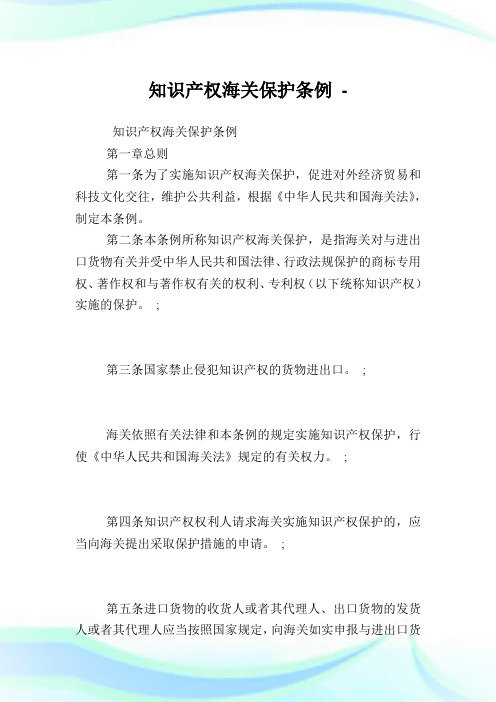
知识产权海关保护条例-知识产权海关保护条例第一章总则第一条为了实施知识产权海关保护,促进对外经济贸易和科技文化交往,维护公共利益,根据《中华人民共和国海关法》,制定本条例。
第二条本条例所称知识产权海关保护,是指海关对与进出口货物有关并受中华人民共和国法律、行政法规保护的商标专用权、著作权和与著作权有关的权利、专利权(以下统称知识产权)实施的保护。
;第三条国家禁止侵犯知识产权的货物进出口。
;海关依照有关法律和本条例的规定实施知识产权保护,行使《中华人民共和国海关法》规定的有关权力。
;第四条知识产权权利人请求海关实施知识产权保护的,应当向海关提出采取保护措施的申请。
;第五条进口货物的收货人或者其代理人、出口货物的发货人或者其代理人应当按照国家规定,向海关如实申报与进出口货物有关的知识产权状况,并提交有关证明文件。
;第六条海关实施知识产权保护时,应当保守有关当事人的商业秘密。
第二章知识产权的备案第七条知识产权权利人可以依照本条例的规定,将其知识产权向海关总署申请备案;申请备案的,应当提交申请书。
申请书应当包括下列内容:(一)知识产权权利人的名称或者姓名、注册地或者国籍等;(二)知识产权的名称、内容及其相关信息;(三)知识产权许可行使状况;(四)知识产权权利人合法行使知识产权的货物的名称、产地、进出境地海关、进出口商、主要特征、价格等;(五)已知的侵犯知识产权货物的制造商、进出口商、进出境地海关、主要特征、价格等。
;前款规定的申请书内容有证明文件的,知识产权权利人应当附送证明文件。
;第八条海关总署应当自收到全部申请文件之日起30个工作日内作出是否准予备案的决定,并书面通知申请人;不予备案的,应当说明理由。
;有下列情形之一的,海关总署不予备案:(一)申请文件不齐全或者无效的;(二)申请人不是知识产权权利人的;(三)知识产权不再受法律、行政法规保护的。
;第九条海关发现知识产权权利人申请知识产权备案未如实提供有关情况或者文件的,海关总署可以撤销其备案。
2012年报关员资格考试备考精选习题及答案解析(五)
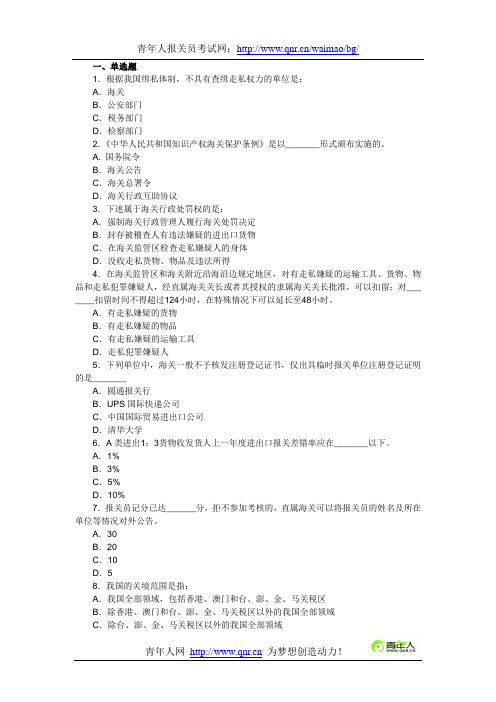
一、单选题1.根据我国缉私体制,不具有查缉走私权力的单位是:A.海关B.公安部门C.税务部门D.检察部门2.《中华人民共和国知识产权海关保护条例》是以_______形式颁布实施的。
A. 国务院令B.海关公告C.海关总署令D.海关行政互助协议3.下述属于海关行政处罚权的是:A.强制海关行政管理人履行海关处罚决定B.封存被稽查人有违法嫌疑的进出口货物C.在海关监管区检查走私嫌疑人的身体D.没收走私货物、物品及违法所得4.在海关监管区和海关附近沿海沿边规定地区,对有走私嫌疑的运输工具、货物、物品和走私犯罪嫌疑人,经直属海关关长或者其授权的隶属海关关长批准,可以扣留;对___ ____扣留时间不得超过124小时,在特殊情况下可以延长至48小时。
A.有走私嫌疑的货物B.有走私嫌疑的物品C.有走私嫌疑的运输工具D.走私犯罪嫌疑人5.下列单位中,海关一般不予核发注册登记证书,仅出具临时报关单位注册登记证明的是_______A.圆通报关行B.UPS国际快递公司C.中国国际贸易进出口公司D.清华大学6.A类进出1:3货物收发货人上一年度进出口报关差错率应在_______以下。
A.1%B.3%C.5%D.10%7.报关员记分已达______分,拒不参加考核的,直属海关可以将报关员的姓名及所在单位等情况对外公告。
A.30B.20C.10D.58.我国的关境范围是指:A.我国全部领域,包括香港、澳门和台、澎、金、马关税区B.除香港、澳门和台、澎、金、马关税区以外的我国全部领域C.除台、澎、金、马关税区以外的我国全部领域D.享有国家特殊优惠政策地区以外的我国全部领域9.根据海关对报关单位分类管理的规定,海关对首次注册登记的报关企业使用类管理措施:A.AAB.AC. BD.C10.进出口货物收发货人进口货物不可采用的报关方式是:A.自理报关B.委托报关行以委托人的名义代理报关C.委托已在海关办理报关注册的货代公司以委托人的名义代理报关D.委托报关公司以报关公司的名义代理报关二、多选题1.报关是指_____向海关办理货物、物品或运输工具进出境手续及相关海关事务的过程。
中华人民共和国知识产权海关保护条例(英文版)
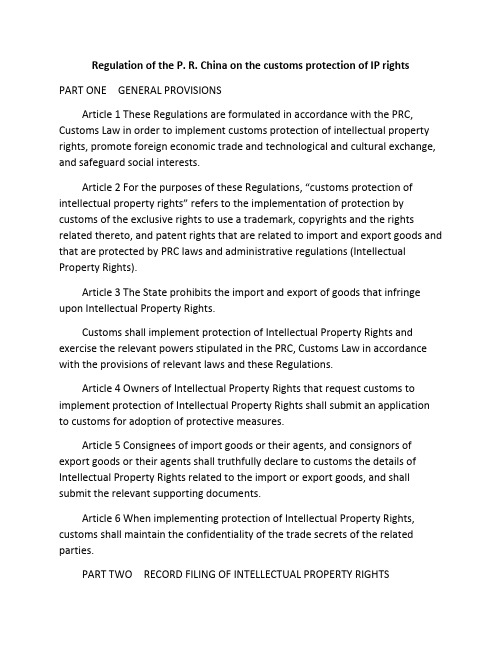
Regulation of the P. R. China on the customs protection of IP rightsPART ONE GENERAL PROVISIONSArticle 1 These Regulations are formulated in accordance with the PRC, Customs Law in order to implement customs protection of intellectual property rights, promote foreign economic trade and technological and cultural exchange, and safeguard social interests.Article 2 For the purposes of these Regulations, “customs protection of intellectual property rights” refers to the implementation of protection by customs of the exclusive rights to use a trademark, copyrights and the rights related thereto, and patent rights that are related to import and export goods and that are protected by PRC laws and administrative regulations (Intellectual Property Rights).Article 3 The State prohibits the import and export of goods that infringe upon Intellectual Property Rights.Customs shall implement protection of Intellectual Property Rights and exercise the relevant powers stipulated in the PRC, Customs Law in accordance with the provisions of relevant laws and these Regulations.Article 4 Owners of Intellectual Property Rights that request customs to implement protection of Intellectual Property Rights shall submit an application to customs for adoption of protective measures.Article 5 Consignees of import goods or their agents, and consignors of export goods or their agents shall truthfully declare to customs the details of Intellectual Property Rights related to the import or export goods, and shall submit the relevant supporting documents.Article 6 When implementing protection of Intellectual Property Rights, customs shall maintain the confidentiality of the trade secrets of the related parties.PART TWO RECORD FILING OF INTELLECTUAL PROPERTY RIGHTSArticle 7 An owner of Intellectual Property Rights may apply to the General Administration of Customs for record filing of his Intellectual Property Rights according to the provisions hereof. To apply for record filing, an application form shall be submitted. An application form shall include the following particulars:1. the name or personal name, place of registration or nationality, etc. of the owner of the Intellectual Property Rights;2. the name, details and the relevant information of the Intellectual Property Rights;3. the details of the exercise of the Intellectual Property Rights license;4. the name, place of origin, customs at the point of entry/exit, importers and exporters, major characteristics, and prices, etc. of the goods of which the Intellectual Property Rights are lawfully exercised by the owner of Intellectual Property Rights; and5. the manufacturers, importers and exporters, customs at the point of entry/exit, major characteristics, and prices, etc. of goods that are known to have infringed upon Intellectual Property Rights.Where there are supporting documents for the contents of the application form specified in the preceding paragraph, the owner of Intellectual Property Rights shall attach the supporting documents.Article 8 The General Administration of Customs shall, within 30 working days of the date of receipt of all application documents, render a decision on whether to grant approval for record filing, and shall notify the applicant in writing. Where approval for record filing is not granted, the reasons therefore shall be stated.The General Administration of Customs shall not grant approval for record filing in any of the following circumstances:1. the application documents are incomplete or invalid;2. the applicant is not the owner of the Intellectual Property Rights; or3. the Intellectual Property Rights are no longer protected by laws or administrative regulations.Article 9 If customs discovers that an owner of Intellectual Property Rights that applies for record filing of Intellectual Property Rights has not provided the relevant details or documents truthfully, the General Administration of Customs may revoke its filed record.Article 10 A filed record for customs protection of Intellectual Property Rights shall be effective as of the date on which the General Administration of Customs grants approval for record filing, and shall be valid for 10 years.Where the Intellectual Property Rights are valid, the owner of the Intellectual Property Rights may, within six months prior to the expiration of the term of validity of the filed record for customs protection of Intellectual Property Rights, apply to the General Administration of Customs for an extension of the filed record. The term of validity of each extension of a filed record shall be 10 years.Where no application for extension has been made upon the expiration of the term of validity of a filed record for customs protection of Intellectual Property Rights, or the Intellectual Property Rights are no longer protected by laws or administrative regulations, the filed record for customs protection of Intellectual Property Rights shall immediately become void.Article 11 Where there is a change in the details of a filed record of Intellectual Property Rights, the owner of the Intellectual Property Rights shall, within 30 working days of the date on which the change occurs, carry out the amendment or cancellation procedures with the General Administration of Customs.Where the owner of the Intellectual Property Rights does not apply to the amendment or cancellation procedures in accordance with the preceding paragraph so as to seriously affect other’s lawful import or export and the Customs supervision according to law, the General Administration of Customs can remove the record upon the application of the stakeholders or take the initiative to do so.PART THREE APPLICATION FOR IMPOUNDMENT OF GOODS SUSPECTED OF INFRINGING UPON RIGHTS, AND THE HANDLING THEREOFArticle 12 Where an owner of Intellectual Property Rights discovers that goods suspected of infringing upon rights are about to be imported or exported, he may submit an application for impoundment of goods suspected of infringing upon rights to the customs of the place where the goods are to enter into, or exit from, China.Article 13 Where an owner of Intellectual Property Rights requests customs to impound goods suspected of infringing upon rights, he shall submit an application form and the relevant supporting documents, and shall provide evidence that is sufficient to prove that the infringement clearly exists.An application form shall include the following main particulars:1. the name or personal name, place of registration or nationality, etc. of the owner of the Intellectual Property Rights;2. the name, details and the relevant information of the Intellectual Property Rights;3. the names of the consignees and consignors of the goods suspected of infringing upon rights;4. the name and specifications, etc. of the goods suspected of infringing upon rights; and5. the port by which, the time at which and the means of transportation by which, the goods suspected of infringing upon rights may enter into, or exit from, China.Where the goods suspected of infringing upon rights are suspected of infringing upon Intellectual Property Rights that are filed for record, the application form shall also include the customs record number.Article 14 Where an owner of Intellectual Property Rights requests customs to impound goods suspected of infringing upon rights, he shall provide to customsa guarantee equal to the value of the goods for compensation of any loss that may be incurred by the consignee or the consignor due to improper application, and for payment of fees for the storage, custody and disposal, etc. of the goods after they are impounded by customs. Where an owner of Intellectual Property Rights pays the fees for storage and custody directly to the storage provider, such fees shall be deducted from the guarantee. The specific procedures shall be formulated by the General Administration of Customs.Article 15 Where an owner of Intellectual Property Rights that applies for impoundment of goods suspected of infringing upon rights satisfies the provisions of Article 13 hereof and provides a guarantee in accordance with Article 14 hereof, customs shall impound the goods suspected of infringing upon rights, notify the owner of Intellectual Property Rights in writing, and deliver a certificate of impoundment by customs to the consignee or consignor.Where an owner of Intellectual Property Rights that applies for impoundment of goods suspected of infringing upon rights does not satisfy the provisions of Article 13 hereof or has not provided a guarantee in accordance with Article 14 hereof, customs shall reject the application and notify the owner of Intellectual Property Rights in writing.Article 16 Where customs discovers import or export goods that are suspected of infringing upon Intellectual Property Rights that are filed for record, it shall notify the owner of the Intellectual Property Rights immediately in writing. Where, within three working days of the date of delivery of the notification, the owner of the Intellectual Property Rights submits an application according to Article 13 hereof and provides a guarantee according to Article 14 hereof, customs shall impound the goods suspected of infringing upon rights, notify the owner of the Intellectual Property Rights in writing, and deliver a certificate of impoundment by customs to the consignee or consignor. Where the owner of the Intellectual Property Rights fails to submit an application or provide a guarantee within the time limit, customs may not impound the goods.Article 17 An owner of Intellectual Property Rights and the consignee or consignor may inspect the relevant goods upon the approval of customs.Article 18 Where the consignee or consignor considers that his goods have not infringed upon the Intellectual Property Rights of the owner of Intellectual Property Rights, he shall submit a written explanation to customs and attach the relevant evidence.Article 19 Where a consignee or consignor of goods suspected of infringing upon patent rights considers that his import or export goods have not infringed upon patent rights, he may, after providing a guarantee equal to the value of the goods, request customs to release his goods. If the owner of Intellectual Property Rights fails to institute an action at a people’s court within a reasonable time period, customs shall return the guarantee.Article 20 If, after customs has discovered import or export goods suspected of infringing upon Intellectual Property Rights that are filed for record and has notified the owner of the Intellectual Property Rights, the owner of the Intellectual Property Rights requests customs to impound the goods suspected of infringing upon rights, customs shall, within 30 working days of the date of impoundment, investigate and confirm whether the impounded goods suspected of infringing upon rights have infringed upon Intellectual Property Rights. If it cannot confirm an infringement, it shall notify the owner of the Intellectual Property Rights immediately in writing.Article 21 Where customs conducts an investigation into the impounded goods suspected of infringing upon rights and requests the assistance of the department in charge of Intellectual Property Rights, the relevant department in charge of Intellectual Property Rights shall provide assistance.Where the department in charge of Intellectual Property Rights requests customs to provide assistance in the handling of rights infringement cases involving import and export goods, customs shall provide assistance.Article 22 Where customs conducts an investigation into the impounded goods suspected of infringing upon rights and the relevant details, the owner of Intellectual Property Rights and the consignee or consignor shall coordinate with the investigation.Article 23 An owner of Intellectual Property Rights may, after applying to customs for adoption of protective measures, apply to the people’s court for an order of cessation of the infringing act or preservation of property for the impounded goods suspected of infringing upon rights prior to the institution of action in accordance with the provisions of the PRC, Trademark Law, the PRC, Copyright Law or the PRC, Patent Law.Customs that receives the notice to assist in execution of an order of cessation of an infringing act or preservation of property from the p eople’s court shall provide assistance.Article 24 Customs shall release the impounded goods suspected of infringing upon rights in any of the following circumstances:1. customs impounds goods suspected of infringing upon rights according to Article 15 hereof, and has not received the notice to assist in execution from the people’s court within 20 working days from the date of impoundment;2. customs impounds goods suspected of infringing upon rights according to Article 16 hereof, and has not received the notice to assist in execution from the people’s court within 50 working days from the date of impoundment, and cannot confirm that the impounded goods suspected of infringing upon rights has infringed upon Intellectual Property Rights after investigation;3. the consignee or consignor of the goods suspected of infringing upon patent rights requests customs to release his goods after providing a guarantee equal to the value of the goods; or4. customs considers that the consignee or consignor has sufficient evidence to prove that his goods have not infringed upon the Intellectual Property Rights of the owner of Intellectual Property rights.Article 25 Where customs impounds goods suspected of infringing upon rights according to the provisions hereof, the owner of the Intellectual Property Rights shall pay the relevant fees for storage, custody and disposal, etc. Where the owner of the Intellectual Property Rights has not paid the relevant fees,customs may deduct such fees from the guarantee he provides to customs, or request the guarantor to perform the relevant guarantee liability.Where goods suspected of infringing upon rights are confirmed as having infringed upon Intellectual Property Rights, the owner of the Intellectual Property Rights may include the relevant fees for storage, custody and disposal, etc. he has paid in the reasonable expenditure paid for cessation of the infringing acts.Article 26 Where customs discovers a case suspected of a criminal offence during implementation of protection of Intellectual Property Rights, it shall hand over the case to the public security authority according to law for handling.PART FOUR LEGAL LIABILITYArticle 27 Where impounded goods suspected of infringing upon rights are confirmed as having infringed upon Intellectual Property Rights after investigation by customs, customs shall confiscate the goods.After customs has confiscated the goods that have infringed upon Intellectual Property Rights, it shall notify the owner of the Intellectual Property Rights in writing of the relevant details of such goods.Where confiscated goods that have infringed upon Intellectual Property Rights can be used for public welfare, customs shall transfer the goods to the relevant public welfare organizations to be used for public welfare. Where the owner of the Intellectual Property Rights wishes to acquire the goods, customs may transfer the goods to the owner of the Intellectual Property Rights for compensation. Where confiscated goods that has infringed upon Intellectual Property Rights cannot be used for public welfare and the owner of the Intellectual Property Rights does not wish to acquire the goods, customs may auction off the goods according to law after removing the infringing characteristics. Where the infringing characteristics cannot be removed, customs shall destroy the goods.Article 28 Where articles carried or sent by mail by individuals into or out of China exceed the amount for personal use or the reasonable amount and infringeupon the Intellectual Property Rights stipulated in Article 2 hereof, customs shall confiscate such articles.Article 29 Where, after customs has accepted an application for record filing of protection of Intellectual Property Rights and for adoption of protective measures for Intellectual Property Rights, an owner of Intellectual Property Rights cannot provide precise details and as a result, the goods infringing upon rights are not discovered, or the protective measures are not adopted in a timely manner or effectively, the owner of the Intellectual Property Rights shall bear the liability himself.Where, after an owner of Intellectual Property Rights has requested customs to impound goods suspected of infringing upon rights, customs cannot confirm whether the impounded goods suspected of infringing upon rights has infringed upon the Intellectual Property Rights of the owner of Intellectual Property Rights, or the people’s court rules that the goods have not infringed upon the Intellectual Property Rights of the owner of Intellectual Property Rights, the owner of Intellectual Property Rights shall be liable for compensation according to law.Article 30 Where the import or export of goods that infringe upon Intellectual Property Rights constitutes a criminal offence, criminal liability shall be pursued according to law.Article 31 Where the personnel of customs are derelict in their duties, abuse their authority or practice graft in their implementation of protection of Intellectual Property Rights, and a criminal offence is constituted, their criminal liability shall be pursued according to law. Where the same is insufficient to constitute a criminal offence, they shall be subjected to administrative penalty according to law.PART FIVE SUPPLEMENTARY PROVISIONSArticle 32 Where an owner of Intellectual Property Rights handles record filing of his Intellectual Property Rights with the General Administration of Customs, he shall pay the fee for record filing in accordance with the relevant State provisions.Article 33 These Regulations shall be implemented as of 1 March 2004. The PRC, Customs Protection of Intellectual Property Rights Regulations promulgated by the State Council on 5 July 1995 shall be simultaneously repealed.。
知识产权海关保护制度

报关与报检实务
任务
第2 页
任 务 知识产权海关保护制度
一、知识产权海关保护概述
《中华人民共和国知识产权海关保护条 例》明确规定,知识产权海关保护是指海 关对与进出口货物有关并受中华人民共和 国法律、行政法规保护的商标专用权、著 作权和与著作权有关的权利、专利权(以 下统称知识产权)实施的保护。
2)
货物价值为人民币2万至20万元的,提供相当于货物价值50%的担保,
但担保金额不得少于人民币2万元;
任务
第 10 页
任 务 知识产权海关保护制度
3)
货物价值超过人民币20万元的,
提供人民币10万元的担保。
经海关同意,知识产权权利人可以向 海关提供总担保。总担保金额不得低于 人民币20万元。
任务
任务
第9 页
任 务 知识产权海关保护制度
(2)知识产权权利人接到海关发现侵权嫌疑货物通知的扣留申请
知识产权权利人在接到海关发现侵权嫌疑货物通知后,认为有关货物侵犯其在 海关总署备案的知识产权并要求海关予以扣留的,应当向海关提出扣留侵权嫌疑货 物的书面申请,并按照以下规定提供担保:
1)
货物价值不足人民币2万元的,提供相当于货物价值的担保;
第 11 页
任 务 知识产权海关保护制度
二、知识产权海关保护制度的基本内容
( 二 ) 扣 留 及侵 其权 处嫌 理疑 货 物 的 申 请
2.被扣留的侵权货物没收后的处理
对没收的侵权货物,海关应当按照下列规定处置:
有关货物可以直接用于社会公益事业或者知识产权权利人有收购
1)
意愿的,将货物转交给有关公益机构用于社会公益事业或者有偿转让
任务
第3 页
任 务 知识产权海关保护制度
最新(完美版)知识产权海关保护条例

第十二章海关知识产权保护条例一、总则相关法条Ⅰ《知识产权海关保护条例》第二条本条例所称知识产权海关保护,是指海关对与进出口货物有关并受中华人民共和国法律、行政法规保护的商标专用权、著作权和与著作权有关的权利、专利权(以下统称知识产权)实施的保护。
第三条国家禁止侵犯知识产权的货物进出口。
第五条进口货物的收货人或者其代理人、出口货物的发货人或者其代理人应当按照国家规定,向海关如实申报与进出口货物有关的知识产权状况,并提交有关证明文件。
第六条海关实施知识产权保护时,应当保守有关当事人的商业秘密。
二、知识产权的备案相关法条Ⅰ《知识产权海关保护条例》第七条【备案申请】知识产权权利人可以依照本条例的规定,将其知识产权向海关总署申请备案;申请备案的,应当提交申请书。
申请书应当包括下列内容:……前款规定的申请书内容有证明文件的,知识产权权利人应当附送证明文件。
第三十二条【备案费】知识产权权利人将其知识产权向海关总署备案的,应当按照国家有关规定缴纳备案费。
相关法条Ⅰ《知识产权海关保护条例》第八条海关总署应当自收到全部申请文件之日起30个工作日...内作出是否准予备案的决定,并书面通知申请人;不予备案的,应当说明理由。
有下列情形之一的,海关总署不予备案:(一)申请文件不齐全或者无效的;(二)申请人不是知识产权权利人的;(三)知识产权不再受法律、行政法规保护的。
相关法条Ⅰ《知识产权海关保护条例》第九条海关发现知识产权权利人申请知识产权备案未如实提供有关情况或者文件的,海关总署可以撤销其备案。
相关法条Ⅰ《知识产权海关保护条例》第十条知识产权海关保护备案自海关总署准予备案之日起生效,有效期为10年。
知识产权有效的,知识产权权利人可以在知识产权海关保护备案有效期届满前6个月内,向海关总署申请续展备案。
每次续展备案的有效期为10年。
知识产权海关保护备案有效期届满而不申请续展或者知识产权不再受法律、行政法规保护的,知识产权海关保护备案随即失效。
- 1、下载文档前请自行甄别文档内容的完整性,平台不提供额外的编辑、内容补充、找答案等附加服务。
- 2、"仅部分预览"的文档,不可在线预览部分如存在完整性等问题,可反馈申请退款(可完整预览的文档不适用该条件!)。
- 3、如文档侵犯您的权益,请联系客服反馈,我们会尽快为您处理(人工客服工作时间:9:00-18:30)。
中华人民共和国知识产权海关保护条例-
中华人民共和国知识产权海关保护条例
发布单位】国务院
【发布文号】中华人民共和国主席令(第179号)
【发布日期】1995年7月10日
【生效日期】1995年10月1
【失效日期】
【所属类别】国家法律法规
中华人民共和国知识产权海关保护条例
(中华人民共和国主席令(第179号))
现发布《中华人民共和国知识产权海关保护条例》,自1995年10月1日起施行。
; ;
总理李鹏
1995年7月5日
中华人民共和国知识产权海关保护条例
第一章总则
第一条为了实施知识产权海关保护,促进对外经济贸易和科技文化交往,维护社会公共利益,根据中华人民共和国有关法律,制定本条例。
; ;
第二条本条例适用于与进出境货物有关并受中华人民共和国法律、行政法规保护的知识产权,包括商标专用权、著作权和专利权。
; ;
第三条侵犯受中华人民共和国法律、行政法规保护的知识产权的货物(以下简称侵权货物),禁止进出口。
; ;
第四条中华人民共和国海关对与进出境货物有关的知识产权实施保护,行使《中华人民共和国海关法》规定的有关权力。
; ;
第五条进口货物的收货人或者出口货物的发货人以及他们的代理人(以下统称收货人或者发货人)应当按照海关的要求,向海关如实申报与进出口货物有关的知识产权状况,交验有关单证。
; ;
第六条知识产权权利人以及他们的代理人(以下统称知识产权权利人)要求海关对其与进出境货物有关的知识产权实施保护的,应当将其知识产权向海关备案,并在其认为必要时向海关提出采取保护措施的申请。
; ;
第七条海关实施知识产权保护时,应当保守有关当事人的商业秘密。
; ;
第二章备案
第八条知识产权权利人申请知识产权海关保护备案的,应当向海关总署提交书面申请。
; ;
申请书应当包括下列内容:
(一)知识产权权利人的名称或者姓名、注册地或者国籍、住所、法定代表人、主要营业场所等;
(二)注册商标的注册号码、内容及有效期限,专利授权的号码、内容及有效期限,或者有关著作权的内容;
(三)与知识产权有关的货物的名称及其产地;
(四)被授权或者许可使用知识产权的人;
(五)与知识产权有关的货物的主要进出境海关、进出口商、主要特征、正常价格等有关情况;
(六)已知的侵权货物的制造商、进出口商、主要进出境海关、主要特征、价格等情况;
(七)海关总署认为应当说明的其他情况。
; ;
提交书面申请时应当附送下列文件:
(一)知识产权权利人身份证件的复制件或者登记注册证书的副本或者经登记注册机关认证的复制件;
(二)注册商标的注册证书复制件,商标局核准转让注册商标的公告或者备案的商标使用许可合同复制件;或者专利证书的复制件,经专利局登记和公告的专利转让合同副本,专利实施许可合同副本;或者著作权权利的证明文件或者证据;
(三)海关总署认为需要附送的其他文件。
; ;
第九条海关总署应当自收到全部申请文件之日起30日内通知申请人是否准予备案。
海关总署准予备案的,发给知识产权海关保护备案证书;不予备案的,应当说明理由。
; ;
第十条知识产权海关保护备案自海关总署准予备案之日起生效,有效期为7年。
; ;
在知识产权有效的前提下,知识产权权利人可以在知识产权海关保护备案有效期届满前6个月内,向海关总署申请续展备
案。
每次续展备案的有效期为7年。
; ;
知识产权海关保护备案有效期届满而不申请续展或者商标专用权、著作权、专利权法律保护期届满的,知识产权海关保护备案随即失效。
; ;
第十一条备案知识产权的情况发生变更的,知识产权权利人应当自知识产权主管部门核准变更之日起10日内向海关总署办理备案变更或者注销手续。
; ;
第三章申请
第十二条在海关总署备案的知识产权权利人发现侵权嫌疑货物即将进出境的,可以向货物进出境地海关提出采取知识产权保护措施的申请。
; ;
第十三条请求海关采取知识产权保护措施的,应当提交书面申请。
; ;
申请书应当包括下列内容:
(一)申请保护的知识产权名称、海关备案号;
(二)侵权嫌疑人名称、住所、法定代表人、主要营业场所;
(三)侵权嫌疑货物名称、规格等有关情况;
(四)侵权嫌疑货物可能进出境的口岸、时间、运输工具、收货人或者发货人等有关情况;
(五)有关侵权的证据;
(六)请求海关采取的措施;
(七)海关认为需要提供的其他内容。
; ;
第十四条申请人请求海关扣留侵权嫌疑货物的,应当向海关提交与进口货物到岸价格或者出口货物离岸价格等值的担保金。
; ;。
